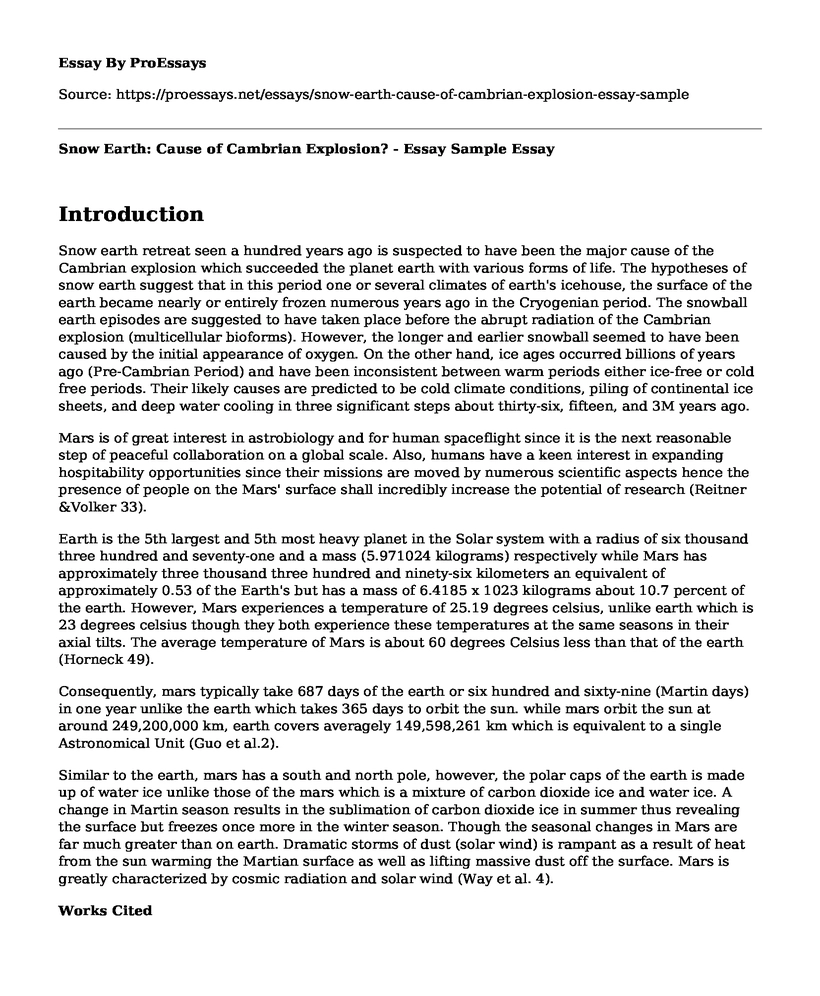Introduction
Snow earth retreat seen a hundred years ago is suspected to have been the major cause of the Cambrian explosion which succeeded the planet earth with various forms of life. The hypotheses of snow earth suggest that in this period one or several climates of earth's icehouse, the surface of the earth became nearly or entirely frozen numerous years ago in the Cryogenian period. The snowball earth episodes are suggested to have taken place before the abrupt radiation of the Cambrian explosion (multicellular bioforms). However, the longer and earlier snowball seemed to have been caused by the initial appearance of oxygen. On the other hand, ice ages occurred billions of years ago (Pre-Cambrian Period) and have been inconsistent between warm periods either ice-free or cold free periods. Their likely causes are predicted to be cold climate conditions, piling of continental ice sheets, and deep water cooling in three significant steps about thirty-six, fifteen, and 3M years ago.
Mars is of great interest in astrobiology and for human spaceflight since it is the next reasonable step of peaceful collaboration on a global scale. Also, humans have a keen interest in expanding hospitability opportunities since their missions are moved by numerous scientific aspects hence the presence of people on the Mars' surface shall incredibly increase the potential of research (Reitner &Volker 33).
Earth is the 5th largest and 5th most heavy planet in the Solar system with a radius of six thousand three hundred and seventy-one and a mass (5.971024 kilograms) respectively while Mars has approximately three thousand three hundred and ninety-six kilometers an equivalent of approximately 0.53 of the Earth's but has a mass of 6.4185 x 1023 kilograms about 10.7 percent of the earth. However, Mars experiences a temperature of 25.19 degrees celsius, unlike earth which is 23 degrees celsius though they both experience these temperatures at the same seasons in their axial tilts. The average temperature of Mars is about 60 degrees Celsius less than that of the earth (Horneck 49).
Consequently, mars typically take 687 days of the earth or six hundred and sixty-nine (Martin days) in one year unlike the earth which takes 365 days to orbit the sun. while mars orbit the sun at around 249,200,000 km, earth covers averagely 149,598,261 km which is equivalent to a single Astronomical Unit (Guo et al.2).
Similar to the earth, mars has a south and north pole, however, the polar caps of the earth is made up of water ice unlike those of the mars which is a mixture of carbon dioxide ice and water ice. A change in Martin season results in the sublimation of carbon dioxide ice in summer thus revealing the surface but freezes once more in the winter season. Though the seasonal changes in Mars are far much greater than on earth. Dramatic storms of dust (solar wind) is rampant as a result of heat from the sun warming the Martian surface as well as lifting massive dust off the surface. Mars is greatly characterized by cosmic radiation and solar wind (Way et al. 4).
Works Cited
Guo, Jingnan, et al. "The in situ Solar Wind and Galactic Cosmic Ray correlation at Mars and its comparison with Earth observations." Geophysical Research Abstracts. Vol. 21. 2019.
Horneck, G. "Astrobiological aspects of Mars and human presence: pros and cons." Hippokratia 12.Suppl 1 (2008): 49.Assessed: https://www.ncbi.nlm.nih.gov/pmc/articles/PMC2577400/
Reitner, Joachim, and Volker Thiel, eds. Encyclopedia of geobiology. Amsterdam: Springer, 2011.doi.org/10.1007/978-1-4020-9212-1_190
Way, Michael, et al. "Comparative atmosphere-ionosphere coupling and climatology of early Earth & Mars." Geophysical Research Abstracts. Vol. 21. 2019. Assessed: https://web.a.ebscohost.com/abstract?direct=true&profile=ehost&scope=site&authtype=crawler&jrnl=10297006&AN=140479720&h=nhcAhe2WlLfxhJUvw0cmPfSZbenRN%2bVwItIxW3vbG0XFFrFmV%2fWvcIa6y0szvExdvSp2kgu9X1VvjCZTdXFYtA%3d%3d&crl=c&resultNs=AdminWebAuth&resultLocal=ErrCrlNotAuth&crlhashurl=login.aspx%3fdirect%3dtrue%26profile%3dehost%26scope%3dsite%26authtype%3dcrawler%26jrnl%3d10297006%26AN%3d140479720
Weiss, David K. "Mars in ice ages for 25% of post-Noachian geologic history." Earth and Planetary Science Letters 528 (2019): 115847. doi.org/10.1016/j.epsl.2019.115847
Cite this page
Snow Earth: Cause of Cambrian Explosion? - Essay Sample. (2023, Jul 06). Retrieved from https://proessays.net/essays/snow-earth-cause-of-cambrian-explosion-essay-sample
If you are the original author of this essay and no longer wish to have it published on the ProEssays website, please click below to request its removal:
- Khoisan of South Africa
- Why Do Bridges Ice Before Roads? Essay Example
- The Hidden Valley of Hollister, CA - A Traffic Haven - Essay Sample
- Mathematics: Kilpatrick's Framework for Learning - Essay Sample
- Bernoulli's Principle for Flow of Fluids: Entrainment, Velocity Measurement, & More - Essay Sample
- Essay Example on Linus Pauling: Nobel Laureate Who Changed Lives
- Solving Cubic Equations: ax3 +bx2 + cx+d=0 - Essay Sample







